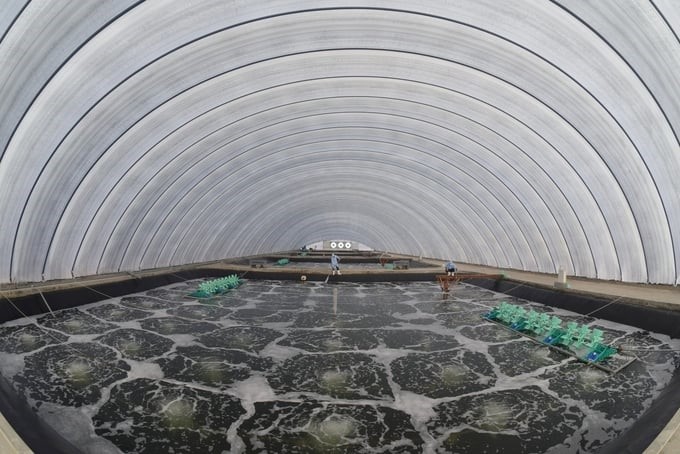May 16, 2025 | 10:20 GMT +7
May 16, 2025 | 10:20 GMT +7
Hotline: 0913.378.918
May 16, 2025 | 10:20 GMT +7
Hotline: 0913.378.918
On July 3, in Hanoi, the Department of Fisheries (Ministry of Agriculture and Rural Development – MARD) held a conference to summarize the direction and management work in the first 6 months of the year and deploy tasks in the last 6 months of 2024.
Mr. Nhu Van Can, Deputy Director of the Department of Fisheries, said that in the first 6 months of the year, the fisheries industry had many advantages when the weather was relatively favorable for exploitation and gasoline prices were relatively stable. Agriculture and rural development strategies, fisheries development strategies, and programs and projects to implement stategies have been approved synchronously.

Deputy Minister of Agriculture and Rural Development Phung Duc Tien highly appreciated the achievements of the fisheries industry in the first 6 months of 2024. Photo: Hong Tham.
However, according to Mr. Can, the fisheries industry also faces many difficulties. Specifically, high prices of some goods and input materials and high logistics costs put pressure on production activities. The situation of drought, saltwater intrusion in the Mekong Delta, and environmental pollution is still complicated. The European Commission (EC) continues to maintain the "yellow card" warning for Vietnamese seafood.
It is estimated that by the end of June 2024, total seafood output would have reached approximately 4.4 million tons, up 2.7% over the same period in 2023. Of which, seafood exploitation output reached more than 1.95 million tons, an increase of 1% over the same period; aquaculture output reached more than 2.43 million tons, up 4.1% over the same period. Seafood export turnover in the first 6 months of the year is estimated to reach nearly USD 4.36 billion, up 4.9% over the same period in 2023.
Director of the Department of Fisheries Tran Dinh Luan assessed that in the first 6 months of 2024, despite many difficulties, production and growth targets were basically met and exceeded. However, one of the targets that is difficult to complete is reducing seafood exploitation output.
Besides, there are also many other difficulties. For example, there is no budget for inspection, especially in the field of breeds and feed, even though there are signs of identification. Therefore, inspection only stops at reminding localities.
Mr. Luan said that inspection is necessary to clearly reveal places using parent shrimp and producing shrimp, fish, or some feed products that do not comply with regulations because these input factors greatly affect people's production.
In addition, in the seafood exploitation field, there are still many problems that need to be overcome. Localities are currently providing capacity support to fishing ports and sub-departments to increase capacity and understanding in certification and validation work, but this is still a gap.

The conference to summarize the direction and management work in the first 6 months of the year and deploy tasks in the last 6 months of 2024 of the Department of Fisheries took place on July 3 in Hanoi. Photo: Hong Tham.
“In the first 6 months of 2024, the fisheries industry has accomplished many things, but there are also many problems. Let's identify together to do better in the last 6 months of the year, with movement in the entire system, in both exploitation and aquaculture. Exploitation and aquaculture must go hand in hand. If exploitation decreases, aquaculture must be next to it," Mr. Luan emphasized.
Mr. Vu Duyen Hai, Head of the Fisheries Exploitation Department (Department of Fisheries), said that the target of seafood exploitation output that we set for 2024 is nearly 3.4 million tons, down 8% compared to 2023. However, in the first 6 months of 2024, the output still increased by 1%.
The goal, according to the strategy, is that seafood exploitation output in 2025 will reach 3.2 million tons, and by 2030, it will only be 2.8 million tons. However, through monitoring the production process and forecasting the fishing grounds in the last 6 months of the year, especially the Northeast monsoon season, it is predicted that the main fishing groups such as tuna, squid, and small offshore fish will continue to be well distributed in traditional fishing grounds such as the Central and Southeast regions. Thus, based on the situation of the fishing grounds and exploitation capacity, from now until the end of the year, the exploitation output will continue to increase. Therefore, the target of reducing exploitation output by 8% compared to 2023 is difficult to achieve.
However, the fisheries industry will continue to make efforts to create momentum for the decline in the following years. Currently, the industry has also proposed a series of tasks to implement Project 208 of the Government, including reducing the number of fishing vessels, reducing output, and changing the profession, hoping to reduce it partly.

Based on the situation of the fishing grounds and exploitation capacity, from now until the end of the year, fishing output will continue to increase, making it difficult to achieve the target of reducing by 8% compared to 2023 as set out. Photo: Hong Tham.
Additionally, according to Mr. Hai, combating IUU fishing is a key activity of the fisheries industry. In recent times, the system of directive documents of the Government, the Prime Minister, MARD, etc. has been very timely, synchronous, focused, and key, so there have been some positive changes. However, in reality, there are still three big problems: preventing fishing vessels from violating foreign waters; handling administrative violations in violating cruise monitoring equipment (VMS); and controlling fishing vessels entering and leaving the port and monitoring output.
Mr. Hai proposed that MARD and the agencies advising the Ministry soon approve the supplement to review and complete the VMS system according to Official Telegram 49 of the Government to increase the penalty rate compared to VMS violations.
At the same time, the electronic seafood traceability system has currently been implemented by 26 provinces and cities, but it has not been fully implemented according to the directive document of the Party Civil Affairs Committee signed by the Deputy Minister of Agriculture and Rural Development.
"Accordingly, in the coming time, in order to be able to fully and completely implement the goals set out in Document No. 419, we hope that the Deputy Minister will direct the advisory units to soon approve the tasks for the Department of Fisheries to further complete the electronic traceability system so that ports can regularly access the system to monitor seafood output in the best way," Mr. Hai further proposed.
Deputy Minister of Agriculture and Rural Development Phung Duc Tien said that attending the summary today was "happy but not very happy." The fisheries industry achieved positive results when total output reached 4.4 million tons, up 2.7% over the same period in 2023. Exploitation output increased by 1%, not decreasing as per the set target. Aquaculture has only reached 42.7%, as planned. The growth rate of the fisheries industry is still slower than that in other industries.
Regarding the seafood exploitation field, the Deputy Minister directed focus on reducing output as the set target, reducing the fleet, and changing the profession. Solving issues related to combating IUU fishing, such as fleet management and fleet monitoring, VMS, paint colors, and the electronic seafood traceability system; and strengthening the handling of administrative violations.
As for aquaculture, more attention must be paid to new processes, technology, and techniques. Solve difficulties for each subject, such as pangasius, shrimp, tuna, molluscs, marine farming, etc. Review norms and standards in the field of marine farming.

As for aquaculture, more attention must be paid to new processes, technology, and techniques. Photo: Hong Tham.
The Deputy Minister highly appreciated the achievements of the fisheries industry in the first 6 months of the year, but the industry must be more determined in exploitation, aquaculture, science and technology, and international cooperation, especially in solving problems related to combating IUU fishing.
The Deputy Minister directed that in the last 6 months of 2024, the fisheries industry must "take advantage of sunny days and win rainy days." Difficulties always come with advantages, which require high concentration.
In the last 6 months of 2024, the fisheries industry set a target of total seafood output reaching 4.89 million tons, of which exploitation output reaches 1.57 million tons and aquaculture output reaches 3.32 million tons. Export turnover reaches USD 5.1 billion.
Translated by Thu Huyen

(VAN) Vietnam's draft amendment to Decree No. 156 proposes a mechanism for medicinal herb farming under forest canopies, linking economic development to population retention and the sustainable protection and development of forests.

(VAN) In reality, many craft village models combined with tourism in Son La have proven effective, bringing significant economic benefits to rural communities.

(VAN) The international conference titled Carbon Market: International experiences and recommendations for Vietnam was successfully held recently in Ho Chi Minh City.

(VAN) According to the Project on rearranging provincial and communal administrative units, in 2025, the country will have 34 provinces/cities, 3,321 communes, wards, and special zones, and no district-level organization.

(VAN) The vice president of fertilizer with Stone X Group says the Trump administration’s tariffs are impacting fertilizer markets.

(VAN) Resolution 57 offers Vietnam a significant opportunity to narrow the global genetic technology disparity and convert its extensive genetic resources into commercial advantages.

(VAN) The Ministry of Agriculture and Environment will prioritize the implementation of five core and breakthrough solutions in science and technology, in addition to the seven groups of tasks identified in Decision No. 503.